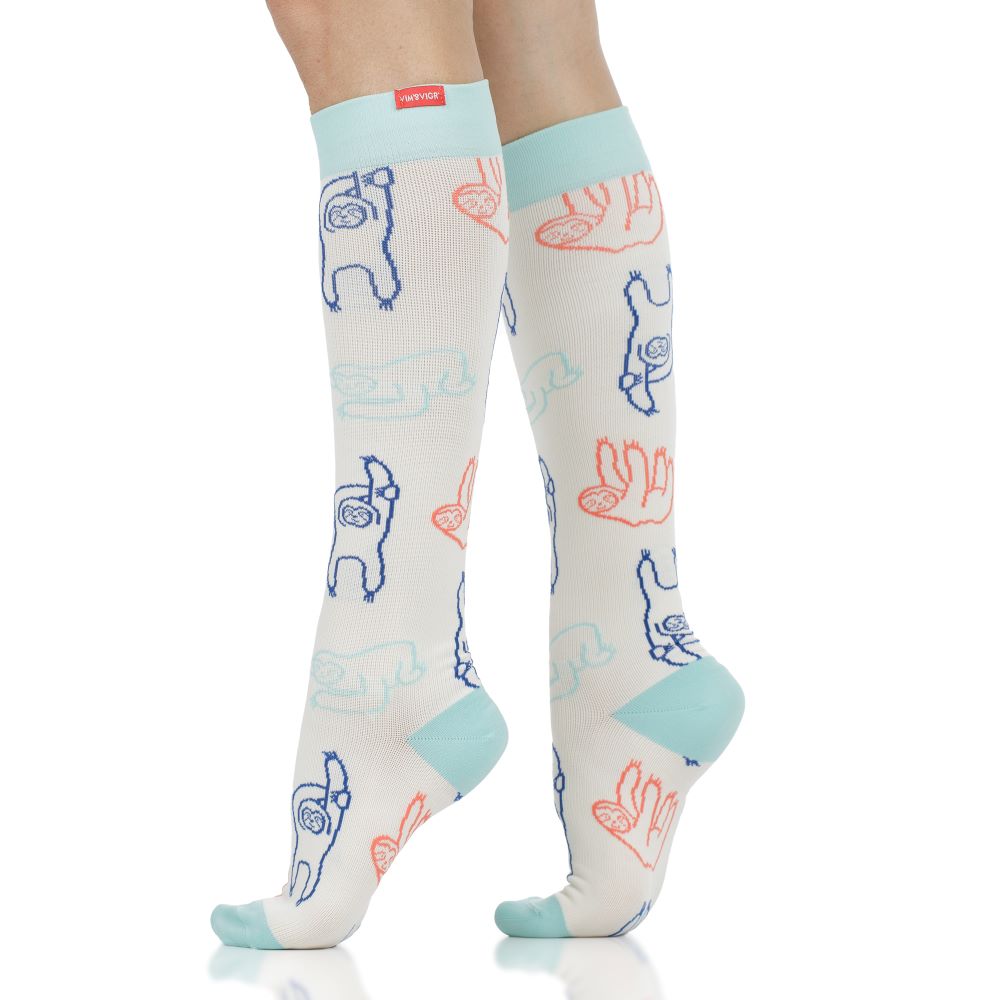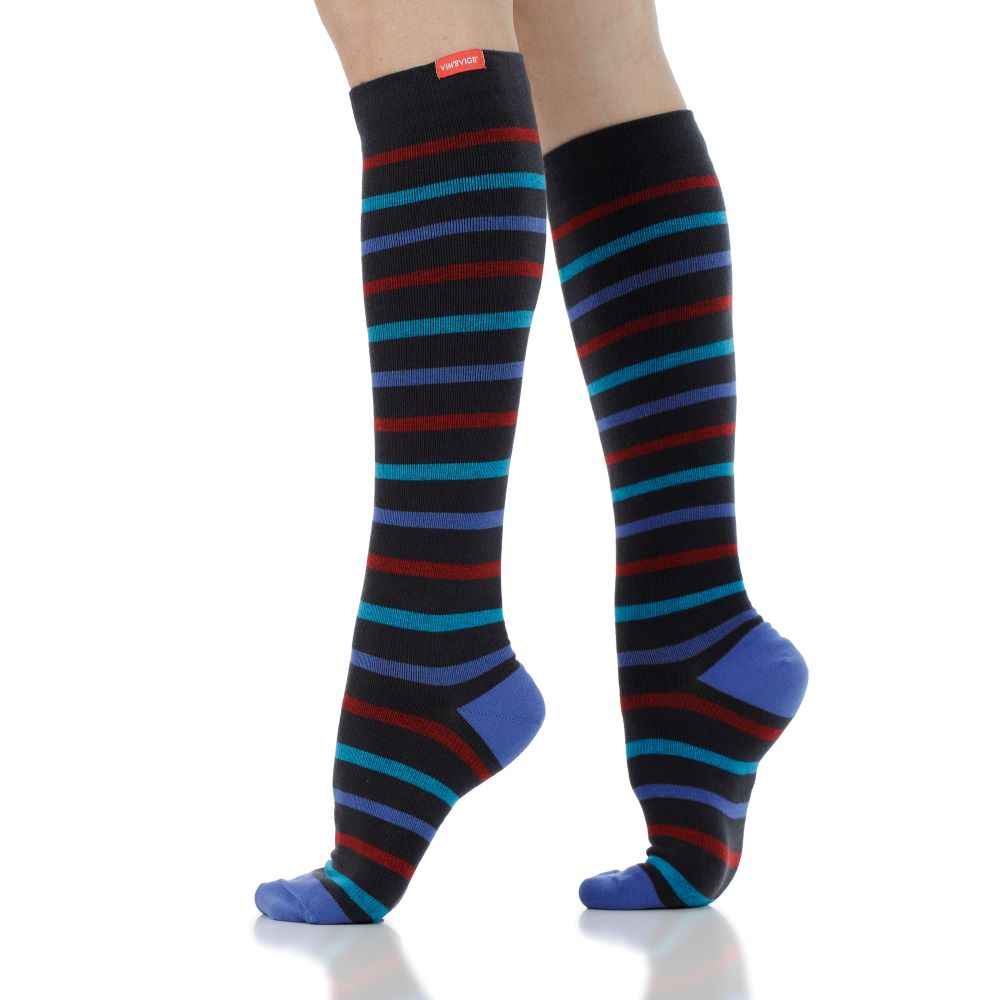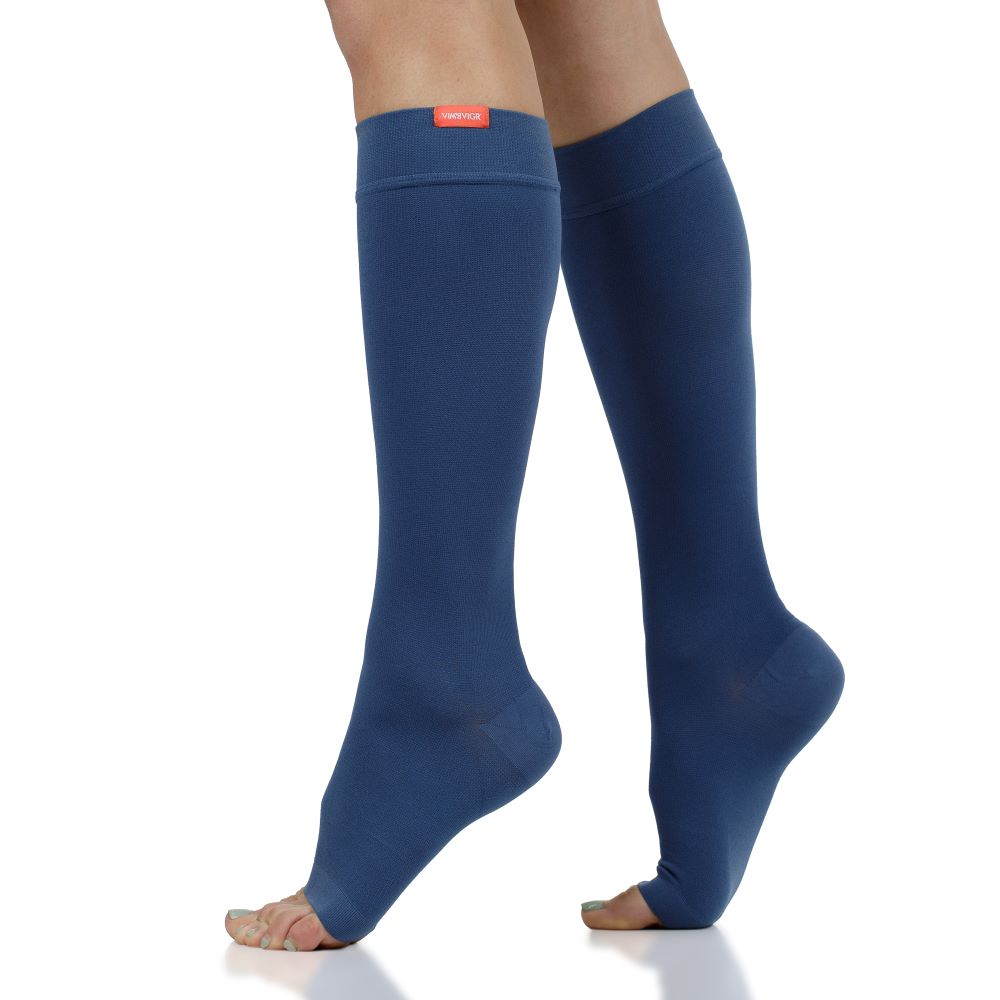10 Unexpected Compression Socks Benefits Backed By Science
Compression socks have many helpful uses: boost peripheral circulation, drain lymph, massage the muscles, and support your joints. Thanks to the therapeutic pressure that compression socks apply to the lower legs, they improve blood flow and can offer the muscles a welcome relief after effort or simply a long day spent on your feet.
But there is more to compression socks than just improving circulation. They can support the muscles and joints when you are returning from injury, diminish the impact of hard landings on joints during exercise, help relieve certain chronic illness symptoms, and more. We have done thorough research for you and put together our top 10 unexpected benefits of compression socks below.
What are the Benefits of Compression Socks?
From boosting blood flow to helping bring down inflammation, reducing fluid retention, and other positive impacts on wellbeing, compression socks and stockings deliver many benefits. Here are our top 10 benefits of wearing compression socks for you to consider.
1. Energize Your Legs
The tight grip that compression socks apply to the legs can boost circulation locally. Research has found that compression socks can even boost circulation at the whole-body level, too. This helps blood flow better throughout the body and deliver oxygen to key organs and muscles, which helps your body function optimally.
Better circulation reduces the feeling of “heavy legs” and the risk of swelling and discomfort when you are on your feet for extended periods of time. That’s good news for teachers and nurses, but also for athletes, hikers, and more.
Healthy blood flow is the key to keeping your body healthy and energized. So, by wearing compression socks, you could boost the levels of energy felt in the legs as well as muscles all over.
2. Reduce Swelling and Fluid Retention
Often, fluid builds up in the lower legs because of poor lymphatic drainage or insufficient blood flow from the legs. Whether it is blood or lymphatic fluid, fluid buildup leads to swollen lower legs and ankles that can cause severe discomfort. The swelling and fluid buildup in your legs can develop into more serious conditions, such as blood clots, lymphedema, for the elderly, etc.
This fluid retention is medically referred to as edema, and doctors often prescribe compression socks to treat edema. Graduated compression is particularly effective because it effectively pushes blood upwards from the lower legs, towards the heart. This helps counteract swelling in your legs by how the compression socks counteract the effect of gravity and helps prevent fluid leaking from the veins into nearby tissues.
Depending on the severity of your edema, you may need to consider different levels of compression in order to treat it. Our socks come in 15-20 mmHg, 20-30 mmHg, and 30-40 mmHg. For mild edema compression socks with 15-20 mmHg of pressure is recommended, for more moderate cases 20-30 mmHg. Typically, 30-40 mmHg comes at the recommendation of a doctor but has been used for edema. If you are unsure what level of compression is best, please consult your healthcare provider.
Explore our compression socks for edema!
3. Alleviate Achiness and Heaviness
The improvement in blood flow, facilitated by compression wear, has been linked with legs that feel of more comfortable, light, and energized. When you’re suffering from sore legs from exercise (particularly delayed onset muscle soreness), compression socks may also massage and soothe the muscles, further helping relieve pain and discomfort.
Finally, compression socks support better peripheral circulation, which means blood is flows more efficiently to the muscles in the lower legs. This implies that compression socks may improve the delivery of oxygen and nutrients to these muscles. This could explain why research has found that compression socks help leg muscles recover after exercise or a particularly busy day.
4. Support Exercise and Muscle Recovery
A key part of muscle recovery is receiving oxygen and nutrients via blood flow. Because they support a healthy circulatory system, compression socks are therefore essential in improving recovery rates and promoting recovery, according to one study. They are also a key part of the “RICE” method that athletes use to recover after hard exercise or when injured.
Compression socks may also reduce the stress on your muscles during a workout or when standing for a long time. According to one scientific review, wearing compression socks when exercising could lead to less damage from the repetitive impact of running, for example (where muscles are subjected to micro vibrations from repeatedly landing on hard surfaces when you run on the road).
As part of a recovery strategy, compression socks also contribute to reducing lactic acid build-up in tired muscles, according to a scientific study. Research shows that this helps reduce the immediate sensations of pain and fatigue when exercising and improve recovery.
5. Improved Focus and Concentration
Important research found that wearing compression garments when sitting still for a long period of time can reduce pain and fatigue, which contributes to feelings of overall comfort and improved parasympathetic nerve system function.
This suggests that wearing compression socks can improve mental performance - after all, who doesn’t work or study better when their legs feel happy and relaxed? It makes compression socks a perfect tool for those in jobs where they sit a lot (most office jobs!).
6. Better Sleep Quality
Sleep is essential for our physical and psychological health. It helps us recover from the daily accumulation of stress and fatigue. However, some health conditions (including poor peripheral circulation, leg tingling, restless leg syndrome, and others) can keep us from sleeping well at night. Research studies suggest that compression socks can reduce the symptoms of these conditions by improving peripheral circulation and facilitating fluid drainage to keep your legs comfortable at night.
Moreover, wearing compression socks may reduce the need to wake up to urinate at night and even with soothing and improving leg comfort in pregnant women, allowing them to sleep better.
7. Improved Circulation for Those Who Sit or Stand All Day
When we spend a lot of time at our desks in office jobs, gravity works against proper blood flow, which can cause our lower legs and ankles to swell up and become sore. Graduated compression socks are tighter at the ankles and gradually reduce pressure as they climb up the leg, pushing blood upwards even while sitting.
The same sort of issues with blood flow can happen when you stand for a long time, for example if you work as a nurse or a teacher. Again, graduated compression socks or stockings push the blood upwards from the lower legs, preventing fluid and blood from pooling around the ankles. This keeps you more energized and the legs feeling light and comfortable all day long.
Browse our range of compression stockings to complete your work outfits
8. Reduce and Prevent Varicose Veins
When the valves within our veins become weakened or damaged, venous insufficiency can develop. As a result, blood flow from the legs becomes really poor and may lead to a circulatory condition called varicose veins.
Because compression socks prevent blood from pooling at the periphery and help maintain good blood circulation throughout the body, compression socks and leg wear are effective at treating the symptoms of varicose veins, according to a classic study. Compression may potentially reduce the likelihood of varicose veins developing and can help manage varicose vein symptoms and offer relief from pain, swelling, and discomfort.
9. Improved Overall Leg and Foot Health
Improved circulation in the lower legs is essential for good health. It keeps the feet, ankles, and lower legs from swelling, suffering from inflammation, edema, lymphedema, and discomfort or pain when sitting or standing for long periods of time.
It goes without saying therefore, that anything that supports better blood flow contributes to good health for the legs and feet. It’s the case with compression socks, which have historically been prescribed by medical professionals routinely for a many conditions. Wear compression socks for prevention of blood circulation problems or in aid of your athletic endeavors.
10. Relief From Chronic Health Conditions
Compression garments may help with a wide range of chronic health conditions, according to a highly cited scientific review. Doctors prescribe them for POTS, neuropathy, orthostatic hypotension, and so much more. Whether it’s for improving the quality of your sleep or for boosting peripheral circulation to reduce swelling, inflammation, and pain, compression socks can be a game changer, if they are appropriate for your particular situation.
Discover compression socks for chronic illnesses
Practical Uses for Compression Socks
Wearing compression garments to support your peripheral circulation is effective, convenient, and even stylish. Here are some top examples of when you should wear them and how to make the most of them.
Compression Socks for Travel
When you prepare for a long plane ride or even a road trip [LINK], add a pair of compression socks to your packing list. Not only will they keep your legs from swelling and hurting from the long hours spent sitting down, compression socks may also boost your energy levels to keep you feeling fresh.
Wear compression socks or stockings during your travel to reduce the risk of developing blood clots or edema. After a long flight or car journey, you can also put on your socks while elevating your feet and relaxing. This helps compressions socks to boost blood flow to the feet and lower legs, soothe sore muscles, and reduce inflammation and swelling.
Compression Socks for Athletes
Athletes of all levels may benefit from wearing compression socks before, during, or after exercise. As a warm-up tool, these stylish items of compression wear improve circulation in the lower legs, helping muscles warm up and loosening tendons and ligaments. This could reduce the risk of sustaining an injury while running or playing tennis, for example.
During exercise, compression socks may provide much needed support to your joints, muscles, and blood vessels. They may also support previously injured joints as you return to exercise (for example, after suffering from Achilles tendonitis), while also reducing the impact of micro vibrations from hard landings on the muscles. Wearing compression sleeves could also reduce fatigue and risk of injuring your calf muscles.
Finally, compression socks have been closely linked to improved recovery after exercise. The increase in localized blood flow helps deliver oxygen and nutrients to the muscles more quickly and efficiently, while soothing inflammation and bringing down any swelling.

Compression Socks During Pregnancy
Pregnant women often suffer from swollen legs and discomfort, caused by fluid retention and poor peripheral circulation. Compression stockings and socks are often prescribed to relieve these symptoms, but also to lower the risk of developing circulatory problems like venous insufficiency caused by the added pressure placed on the veins during this period.
FAQs About the Benefits of Compression Socks
How Do Compression Socks Improve Circulation?
Graduated compression socks are tighter at the ankle and slowly release pressure as they climb up the legs. This therapeutic pressure stimulates the local blood flow, but also pushes blood back from your extremities towards the heart. As a result, healthy blood flow is maintained even when you are standing or sitting for a long period of time.
Are There Any Age Restrictions for Wearing Compression Socks?
Compression socks deliver benefits to people of all ages since they improve lower leg circulation and support the muscles and joints during exercise. Some health conditions that benefit from compression socks tend to manifest themselves later in life, but anyone can wear compression socks for as long as they feel comfortable and enjoy the benefits of lighter legs and improved circulation.
Who Shouldn’t Use Compression Socks?
Generally, compression socks are very safe to use and can be worn by anyone for as long as they feel comfortable. The key is to listen to your body and to ensure you’re wearing the right size and fit for you.
For some people, compression socks may be uncomfortable or not appropriate because of certain medical conditions. You should never wear compression socks over open wounds or sores. Always consult with your doctor to see if compression garments are recommended in your condition, especially if you have any doubts.
References
Vaile, J., Stefanovic, B., & Askew, C. D. (2016). Effect of lower limb compression on blood flow and performance in elite wheelchair rugby athletes. The journal of spinal cord medicine, 39(2), 206–211. Read it here.
O'Riordan, S. F., Bishop, D. J., Halson, S. L., & Broatch, J. R. (2022). Compression-induced improvements in post-exercise recovery are associated with enhanced blood flow, and are not due to the placebo effect. Scientific reports, 12(1), 16762. Read it here.
Mota, G. R., Simim, M. A. M., Dos Santos, I. A., Sasaki, J. E., & Marocolo, M. (2020). Effects of Wearing Compression Stockings on Exercise Performance and Associated Indicators: A Systematic Review. Open access journal of sports medicine, 11, 29–42. Read it here.
Berry, M. J., & McMurray, R. G. (1987). Effects of graduated compression stockings on blood lactate following an exhaustive bout of exercise. American journal of physical medicine, 66(3), 121–132. Read it here.
Engel, F. A., Holmberg, H. C., & Sperlich, B. (2016). Is There Evidence that Runners can Benefit from Wearing Compression Clothing? Sports medicine (Auckland, N.Z.), 46(12), 1939–1952. Read it here.
Horiuchi, M., Takiguchi, C., Kirihara, Y., & Horiuchi, Y. (2018). Impact of Wearing Graduated Compression Stockings on Psychological and Physiological Responses during Prolonged Sitting. International journal of environmental research and public health, 15(8), 1710. Read it here.
Thaler, E., Huch, R., Huch, A., & Zimmermann, R. (2001). Compression stockings prophylaxis of emergent varicose veins in pregnancy: a prospective randomised controlled study. Swiss medical weekly, 131(45-46), 659–662. Read it here.
Lim, C. S., & Davies, A. H. (2014). Graduated compression stockings. CMAJ : Canadian Medical Association journal = journal de l'Association medicale canadienne, 186(10), E391–E398. Read it here.






















Is it common for an amputee to develop swelling in his full leg and foot several years after the amputation or is the swelling unrelated to the amputation below the knee? Thank you for any help you can provide
Leave a comment